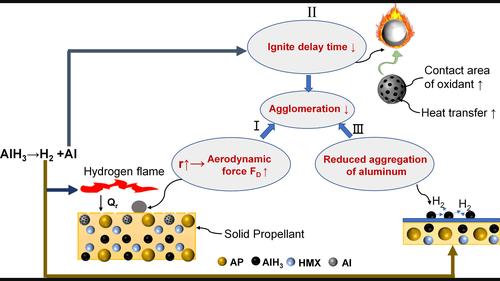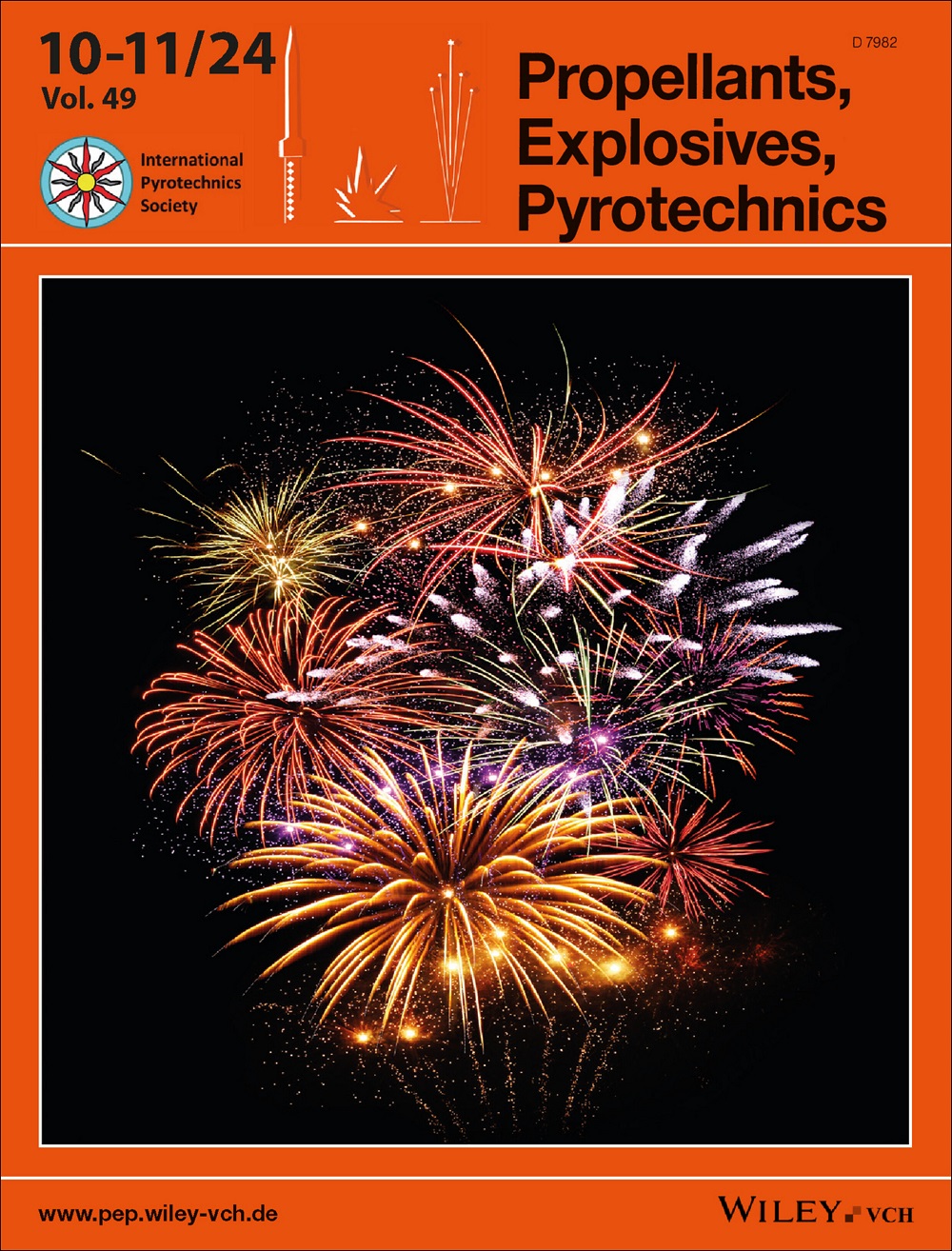Reduction of agglomeration effect by aluminum trihydride in solid propellant combustion
IF 2
4区 工程技术
Q3 CHEMISTRY, APPLIED
引用次数: 0
Abstract
Aluminum trihydride (AlH3) has gained considerable attention as a substitute fuel for aluminum in solid propellants. In this study, we conducted a systematic investigation to evaluate the effects of AlH3 content, ranging from 0 % to 18 %, on propellant ignition, combustion, and agglomeration. Experimental methods such as thermogravimetry−differential scanning calorimetry (TG-DSC), laser ignition, high-speed photography, and collecting condensed combustion products (CCPs) were employed. The results indicate that AlH3 significantly promotes the high-temperature decomposition of ammonium perchlorate (AP). Meanwhile, the addition of cyclotetramethylene tetranitramine (HMX) in propellant does not affect the hydrogen release reaction of AlH3. As the AlH3 content increases from 0 % to 18 %, the spectral emission intensity of the propellants decreases, and the ignition delay time initially increases from 253 ms to 321 ms, and then decreases to 258 ms. Furthermore, the burning rate increases with increasing the AlH3 content, while the pressure exponent is reduced from 0.551 to 0.460. The inclusion of AlH3 in propellants significantly inhibits aluminum agglomeration near the burning surface. Additionally, as the AlH3 content increases, the mean particle size D43 of the CCPs decreases from 50.95 μm to 8.28 μm at 1 MPa. The agglomeration degree of aluminum is very weak at 7 MPa, especially when the AlH3 content exceeds 9 %. The conclusions drawn from this study can serve as valuable guidance for optimizing propellant formulations.

用三酸化铝降低固体推进剂燃烧中的结块效应
三氢化铝(AlH3)作为固体推进剂中铝的替代燃料受到了广泛的关注。在这项研究中,我们进行了系统的调查,以评估AlH3含量(0 - 18%)对推进剂点火、燃烧和团聚的影响。实验方法包括热重-差示扫描量热法(TG-DSC)、激光点火、高速摄影和收集凝聚燃烧产物(CCPs)。结果表明,AlH3对高氯酸铵(AP)的高温分解有明显的促进作用。同时,推进剂中加入环四亚甲基四胺(HMX)对AlH3的氢释放反应没有影响。随着AlH3含量从0%增加到18%,推进剂的光谱发射强度降低,点火延迟时间从253 ms先增加到321 ms,再减少到258 ms。燃烧速率随AlH3含量的增加而增加,压力指数由0.551降至0.460。推进剂中掺入AlH3可显著抑制燃烧表面附近铝的团聚。在1mpa下,随着AlH3含量的增加,CCPs的平均粒径D43从50.95 μm减小到8.28 μm。在7 MPa时,铝的团聚程度很弱,特别是当AlH3含量超过9%时。所得结论对优化推进剂配方具有重要的指导意义。
本文章由计算机程序翻译,如有差异,请以英文原文为准。
求助全文
约1分钟内获得全文
求助全文
来源期刊

Propellants, Explosives, Pyrotechnics
工程技术-工程:化工
CiteScore
4.20
自引率
16.70%
发文量
235
审稿时长
2.7 months
期刊介绍:
Propellants, Explosives, Pyrotechnics (PEP) is an international, peer-reviewed journal containing Full Papers, Short Communications, critical Reviews, as well as details of forthcoming meetings and book reviews concerned with the research, development and production in relation to propellants, explosives, and pyrotechnics for all applications. Being the official journal of the International Pyrotechnics Society, PEP is a vital medium and the state-of-the-art forum for the exchange of science and technology in energetic materials. PEP is published 12 times a year.
PEP is devoted to advancing the science, technology and engineering elements in the storage and manipulation of chemical energy, specifically in propellants, explosives and pyrotechnics. Articles should provide scientific context, articulate impact, and be generally applicable to the energetic materials and wider scientific community. PEP is not a defense journal and does not feature the weaponization of materials and related systems or include information that would aid in the development or utilization of improvised explosive systems, e.g., synthesis routes to terrorist explosives.
 求助内容:
求助内容: 应助结果提醒方式:
应助结果提醒方式:


